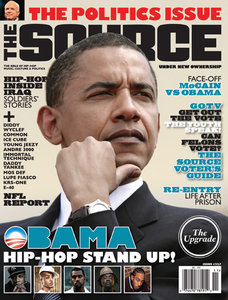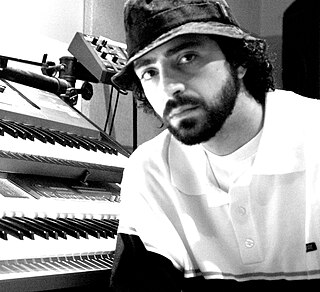Related Research Articles
Old-school hip hop is the earliest commercially recorded hip hop music and the original style of the genre. It typically refers to the music created around 1979 to 1983, as well as any hip hop that does not adhere to contemporary styles.
The new school of hip hop was a movement in hip hop music, beginning in 1983–84 with the early records of Run–D.M.C., Whodini, and LL Cool J. Predominantly from Queens and Brooklyn, it was characterized by Drum Machine-led minimalism, often tinged with elements of Rock; rapped taunts, boasts, and socio-political commentary; and aggressive, self-assertive delivery. In song and image, its artists projected a tough, cool, street B-boy attitude. These elements contrasted sharply with Funk and Disco, Novelty hits, live bands, synthesizers, and party rhymes of artists prevalent in the early 1980s. Compared to their older hip hop counterparts, new school artists crafted more cohesive LPs and shorter songs more amenable to airplay. By 1986, their releases began to establish hip hop in the mainstream.

James Todd Smith, known professionally as LL Cool J, is an American rapper and actor. He is one of the earliest rappers to achieve commercial success, alongside fellow new school hip hop acts Beastie Boys and Run-DMC.

Mantronix was an influential 1980s hip hop and electro funk music group from New York City. The band was formed by DJ Kurtis Mantronik and rapper MC Tee. The group is primarily remembered for its pioneering blend of old school hip hop, electronic, and club music. They underwent several genre and line-up changes during its seven-year existence between 1984 and 1991, and released five albums beginning with their 1985 debut The Album.
Electro is a genre of electronic dance music directly influenced by the use of the Roland TR-808 drum machines, with an immediate origin in early hip hop and funk genres. Records in the genre typically feature heavy electronic sounds, usually without vocals; if vocals are present, they are delivered in a deadpan manner, often through electronic distortion such as vocoding and talkboxing. It palpably deviates from its predecessor boogie by being less vocal-oriented and more focused on electronic beats produced by drum machines.

Shawn Moltke, better known by his stage name MC Shan, is an American rapper, singer and record producer from New York City. He is best known for his guest appearance and production on Canadian singer Snow's 1992 single "Informer", which peaked atop the Billboard Hot 100. Shan is also known for his 1986 single "The Bridge," which was produced by Marley Marl and entered the Hot R&B/Hip-Hop Songs chart.

The Source is an American hip hop and entertainment website, and a magazine that publishes annually or semiannually. It is the world's longest-running rap periodical, being founded as a newsletter in 1988 by David Mays.

Melvin Glover, better known by his stage name Grandmaster Melle Mel or simply Melle Mel, is an American rapper who was the lead vocalist and songwriter of Grandmaster Flash and the Furious Five.

Douglas Davis, known professionally as Doug E. Fresh, is a Barbadian-born American rapper, record producer, and beatboxer, also known as the "Human Beat Box". The pioneer of 20th-century American beatboxing, Fresh is able to accurately imitate drum machines and various special effects using only his mouth, lips, gums, throat, tongue and a microphone.

Urban Dance Squad was a Dutch rap rock band formed after what was originally intended as a one-time jam-session at a festival in Utrecht on December 20, 1986. The band consisted of a guitarist, bassist, drummer, rapper, and DJ. Urban Dance Squad was one of the most successful Dutch bands of the nineties, releasing five studio albums.
John "Mr. Magic" Rivas, was a Puerto Rican hip hop radio DJ.

Farid Karam Nassar, better known by his stage name Fredwreck, is an American hip-hop recording artist, DJ, and record producer. He got his big break when he became a producer for Dr. Dre's newly founded record label Aftermath Entertainment, and then went on to work with Snoop Dogg's record label Dogghouse Records and became a known producer on Tha Dogg Pound-affiliated material. During this time he also was a producer for Snoop Dogg's track: Riders on the Storm ft. The Doors on EA's Need for Speed Underground 2. He has produced tracks from Kurupt's Tha Streetz Iz a Mutha and most of his next release, Space Boogie: Smoke Oddessey; both released during the period the rapper had left Death Row Records. He has also produced for other hip-hop and pop artists such as Eminem, Britney Spears, Ice Cube, Westside Connection, Lil' Kim, Hilary Duff, Xzibit, The Game, Nate Dogg, Everlast, Cypress Hill, 50 Cent, Mobb Deep, as well as non-US acts such as Dizzee Rascal, Tamer Hosny, Qusai Kheder and Karl Wolf.

Krush Groove is a 1985 American musical comedy-drama film distributed by Warner Bros. Pictures that was written by Ralph Farquhar and directed by Michael Schultz. This film is loosely based on the early days of Def Jam Recordings and up-and-coming record producer Russell Simmons, portrayed by Blair Underwood in his feature film debut. Simmons was the film's co-producer and story consultant; he also had a cameo in the film as a club owner named Crocket.

Golden age hip hop refers to hip hop music created from the mid or mid-late 1980s to the early or early-mid 1990s, particularly by artists and musicians originating from the New York metropolitan area. A precursor to the new-school hip hop movement, it is characterized by its diversity, quality, innovation and influence on overall hip hop after the genre's emergence and establishment in the old-school era, and is associated with the development and eventual mainstream success of hip hop. There were various types of subject matter, while the music was experimental and the sampling from old records was eclectic.

Joseph Robert Saddler, known by his stage name Grandmaster Flash, is an American musician and DJ. He created a DJ technique called the Quick Mix Theory. This technique serviced the break-dancer and the rapper by elongating the drum breaks through the use of duplicate copies of vinyl. This technique gave birth to cutting and scratching. It also gave rappers better music with a seamless elongated bed of beats to speak on. He also invented the slipmat.
Brian Harmon, better known by his stage name Champtown, is an American rapper, disc jockey, film director and teacher from Detroit, Michigan. Founder of the Straight Jacket independent record label, Champtown is known for helping establish the careers of a number of Detroit hip hop artists, including Kid Rock. He has also worked with Ice-T, Rev Run, Public Enemy and Uncle Kracker. He produced a documentary film, The Untold Story of Detroit Hip Hop, which featured interviews with notable Detroit rappers.

Run-DMC was an American hip hop group from Hollis, Queens, New York City, formed in 1983 by Joseph Simmons, Darryl McDaniels, and Jason Mizell. Run-DMC is regarded as one of the most influential acts in the history of hip hop culture and especially one of the most famous hip hop acts of the 1980s. Along with Beastie Boys, LL Cool J, DJ Jazzy Jeff & the Fresh Prince, and Public Enemy, the group pioneered new-school hip hop music and helped usher in the golden age of hip hop. The group was among the first to highlight the importance of the MC and DJ relationship.

Contact High: A Visual History of Hip-Hop is a 2018 photography book created and written by Vikki Tobak and ongoing exhibition series. The volume features contact prints from analog photography sessions of hip hop artists during roughly forty-years, from the beginnings of the genre in the late 1970s until the late 2000s.

Sophie Bramly is a French photographer, television producer/director, digital pioneer, and author. She’s best known for the hip-hop photos she shot in New York in the early Eighties, the creation of hip-hop television show Yo! MTV Raps she produced and hosted for MTV Europe in the late 80s and early 90s, and the website and online community dedicated to female pleasure she established in Paris in 2008. This career has been described as “protean” in Le Figaro. In 2017 France's Ministry of Culture named Bramly a Chevalier de l'Ordre des Arts et des Lettres.
References
- 1 2 3 VANTHILT, Marcel, "Marcel 55", Lido, 2012, page 107-111.
- ↑ "Laatste nieuws, sportnieuws, vacatures, uitgaan Almere - dichtbij.nl". dichtbij.nl. Archived from the original on 2014-03-18. Retrieved 2015-05-28.
- ↑ "Hiphopdocu Big Fun In The Big Town na 25 jaar op dvd". 3voor12. 16 May 2012.
- ↑ "'Big Fun in the Big Town': '80s cult fave comes to DVD". USATODAY.COM.
- ↑ Caramanica, Jon (June 21, 2012). "On DVD, 'Big Fun in the Big Town' and Diana Ross in Concert". The New York Times– via NYTimes.com.
- ↑ "Bram van Splunteren". bramvansplunteren.nl. Archived from the original on 2015-05-29. Retrieved 2015-05-29.
- ↑ Michael Hann (18 May 2013). "The 10 best music documentaries". the Guardian.
- ↑ Purple Revolver. "Big Fun In The Big Town DVD and soundtrack re-issue unleashed". purplerevolver.com.
- ↑ "Various - Music That Inspired The Cult Film "Big Fun In The Big Town"". Discogs. 2012.